
Register your product and get support at
www.philips.com/welcome
HTS5563
HTS5593

Register your product and get support at
www.philips.com/welcome
HTS5563
HTS5593

Contents
English
EN 1

1 Help and support
Philips provides extensive online support.Visit our website at www.philips.com/support to:
???download the complete user manual
???print the quick start guide
???watch video tutorials (available only for selected models)
???find answers to frequently answered questions (FAQs)
???email us a question
???chat with our support representative. Follow the instructions on the website to select your language, and then enter your product model number.
Alternatively, you can contact Philips Consumer Care in your country. Before you contact Philips, note down the model number and serial number of your product.You can find this information on the back or bottom of your product.
Use onscreen Help (user manual)
For easy access, the onscreen help (user manual) is stored on your home theater.
The onscreen help has two panels.
???The left panel contains two tabs - Contents and Index. Navigate the Contents or Index to select a topic.The legends used to display the Contents are as follows:
??? : Press OK to expand the subtopics.
: Press OK to expand the subtopics.
??? : Press OK to collapse the subtopics, or press Navigation buttons (up/down) to select a topic.
: Press OK to collapse the subtopics, or press Navigation buttons (up/down) to select a topic.
???The right panel contains the content of the selected topic. For additional help on the content, scroll down the page to see Related topics.
Use the home theater remote control to select and navigate the onscreen help (see 'Navigate onscreen Help' on page 2).
Navigate onscreen Help
Press a button on your remote control to use onscreen help.
2 EN

2 Important
Read and understand all instructions before you use your product. If damage is caused by failure to follow instructions, the warranty does not apply.
Safety
Risk of electric shock or fire!
???Never expose the product and accessories to rain or water. Never place liquid containers, such as vases, near the product. If liquids are spilt on or into the product, disconnect it from the power outlet immediately. Contact Philips Consumer Care to have the product checked before use.
???Never place the product and accessories near naked flames or other heat sources, including direct sunlight.
???Never insert objects into the ventilation slots or other openings on the product.
???Where the mains plug or an appliance coupler is used as the disconnect device, the disconnect device shall remain readily operable.
???Disconnect the product from the power outlet before lightning storms.
???When you disconnect the power cord, always
pull the plug, never the cable.
Risk of short circuit or fire!
???Before you connect the product to the power outlet, ensure that the power voltage matches the value printed on the back or bottom of the product. Never connect the product to the power outlet if the voltage is
different.
Risk of injury or damage to the home theater!
???For
???For speakers with stands, use only the supplied stands. Secure the stands to the speakers tightly. Place the assembled stands on flat, level surfaces that can support the combined weight of the speaker and stand.
???Never place the product or any objects on power cords or on other electrical equipment.
???If the product is transported in temperatures below 5??C, unpack the product and wait until its temperature matches room temperature before connecting it to the power outlet.
???Visible and invisible laser radiation when open. Avoid exposure to beam.
???Do not touch the disc optical lens inside the disc compartment.
???Parts of this product can be made of glass.
Handle with care to avoid injury and damage.
Risk of overheating!
???Never install this product in a confined space.
Always leave a space of at least four inches around the product for ventilation. Ensure curtains or other objects never cover the
ventilation slots on the product.
Risk of contamination!
???Do not mix batteries (old and new or carbon and alkaine, etc.).
???Danger of explosion if batteries are incorrectly replaced. Replace only with the same or equivalent type.
???Remove batteries if they are exhausted or if the remote control is not to be used for a long time.
???Batteries contain chemical substances, they
should be disposed of properly.
Risk of swallowing batteries!
???The product/remote control may contain a coin/button type battery, which can be swallowed. Keep the battery out of reach of children at all times! If swallowed, the battery can cause serious injury or death. Severe internal burns can occur within two hours of ingestion.
???If you suspect that a battery has been swallowed or placed inside any part of the body, seek immediate medical attention.
???When you change the batteries, always keep all new and used batteries out of reach of children. Ensure that the battery compartment is completely secure after you replace the battery.
???If the battery compartment cannot be completely secured, discontinue use of the product. Keep out of reach of children and contact the manufacturer.
English
EN 3
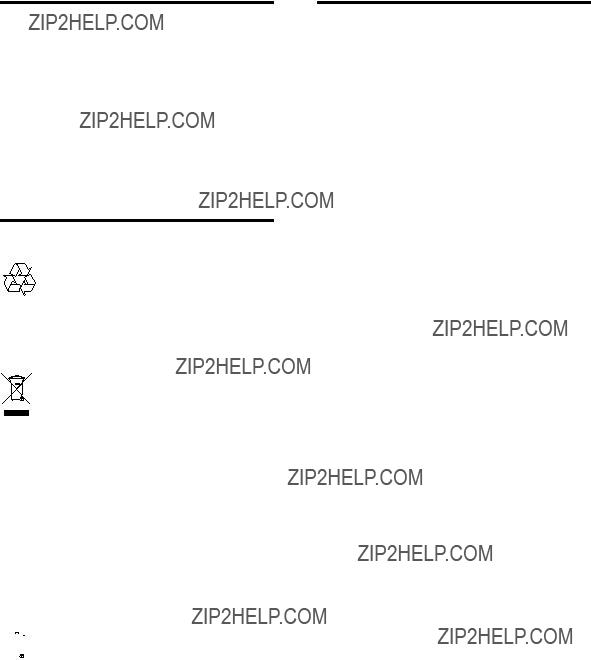
Care for your product
???Do not insert any objects other than discs into the disc compartment.
???Do not insert warped or cracked discs into the disc compartment.
???Remove discs from the disc compartment if you are not using the product for an extended period of time.
???Use only microfiber cloth to clean the product.
Care of the environment
Your product is designed and manufactured with high quality materials and components, which can be recycled and reused.
When this
Please act according to your local rules and do not dispose of your old products with your normal household waste.
Correct disposal of your old product helps to prevent potential negative consequences for the environment and human health.
Your product contains batteries covered by the European Directive 2006/66/EC, which cannot be disposed with normal household waste.
Please inform yourself about the local rules on separate collection of batteries because correct disposal helps to prevent negative consequences for the environmental and human health.
3D health warning
If you or your family has a history of epilepsy or photosensitive seizures, consult a medical professional before exposing yourself to flashing light sources, rapid image sequences or 3D viewing.
To avoid discomfort such as dizziness, headache or disorientation, we recommend not watching 3D for extended periods of time. If you experience any discomfort, stop watching 3D and do not immediately engage in any potentially hazardous activity (for example driving a car) until your symptoms have disappeared. If symptoms persist, do not resume watching 3D without consulting a medical professional first.
Parents should monitor their children during 3D viewing and ensure they do not experience any discomfort as mentioned above.Watching 3D is not recommended for children under six years of age as their visual system is not fully developed yet.
4 EN
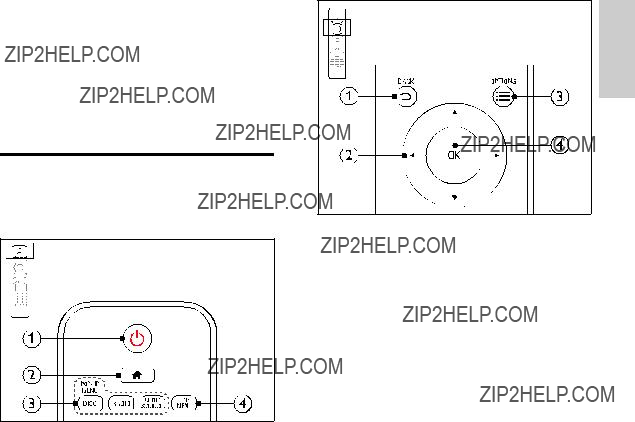
3 Your home theater
Congratulations on your purchase, and welcome to Philips! To fully benefit from the support that
Philips offers, register your product at www.philips. com/welcome.
Remote control
This section includes an overview of the remote control.
A
???Switch the home theater on or to standby.
???When EasyLink is enabled, press and hold for at least three seconds to switch all connected HDMI CEC compliant devices to standby.
B (Home)
(Home)
Access the home menu.
CSource buttons
???
???RADIO: Switch to FM radio.
???AUDIO SOURCE: Select an audio input source.
DTOP MENU
Access the main menu of a video disc.
English
A BACK
BACK
???Return to a previous menu screen.
???In radio mode, press and hold to erase the current preset radio stations.
BNavigation buttons
???Navigate menus.
???In radio mode, press left or right to start auto search.
???In radio mode, press up or down to tune the radio frequency.
C
 OPTIONS
OPTIONS
???Access more play options while playing a disc or a USB storage device.
???In radio mode, set a radio station.
DOK
Confirm an entry or selection.
EN 5
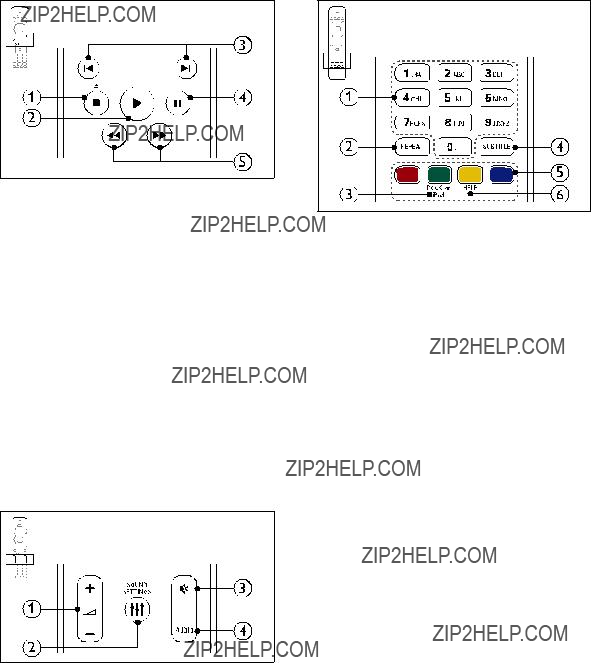
A (Stop) /
(Stop) /  (Eject/Open/Close)
(Eject/Open/Close)
???Stop play.
???Press and hold for three seconds to open or close the disc compartment, or eject the disc.
B (Play)
(Play)
Start or resume play.
C /
/  (Previous/Next)
(Previous/Next)
???Skip to the previous or next track, chapter or file.
???In radio mode, select a preset radio station.
D (Pause)
(Pause)
Pause play.
E /
/  (Fast Backward/Fast Forward)
(Fast Backward/Fast Forward)
Search backwards or forward. Press repeatedly to change the search speed.
A +/- (Volume)
+/- (Volume)
Increase or decrease volume.
B
 SOUND SETTINGS
SOUND SETTINGS
Access or exit sound options.
C (Mute)
(Mute)
Mute or restore volume.
DAUDIO
Select an audio language or channel.
6 EN
AAlphanumeric buttons
Enter values or letters (using SMS style entry).
BREPEAT
Select or turn off repeat mode.
CDOCK for iPod
Switch to Philips dock for iPod or iPhone.
DSUBTITLE
Select subtitle language for video.
EColor buttons
Select tasks or options for
FHELP
Access the onscreen help.
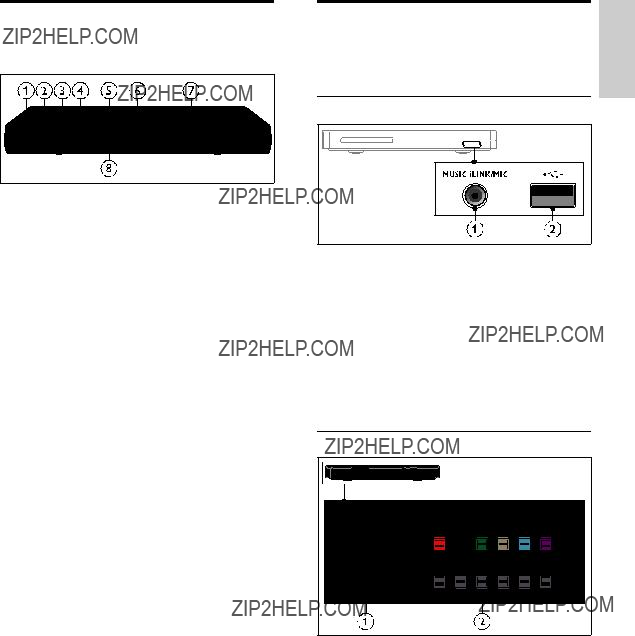
Main unit
This section includes an overview of the main unit.
A
Switch the home theater on or to standby.
B (Play/Pause)
(Play/Pause)
Start, pause or resume play.
C (Stop)
(Stop)
???Stop play.
???In radio mode, press and hold to erase the current preset radio stations.
DSOURCE
Select an audio or video source for the home theater.
E +/-
+/-
Increase or decrease volume.
F (Open/Close)
(Open/Close)
Open or close the disc compartment, or eject the disc.
GDisplay panel
HDisc compartment
Connectors
This section includes an overview of the connectors available on your home theater.
Front connectors
AMUSIC iLINK / MIC (MIC is available only in selected models)
Audio input from an MP3 player or a microphone.
Audio input from a microphone. (Available only in selected models)
B (USB)
(USB)
Audio, video or picture input from a USB storage device.
Rear left
AAC MAINS~
Connect to the power supply.
BSPEAKERS
Connect to the supplied speakers and subwoofer.
English
EN 7
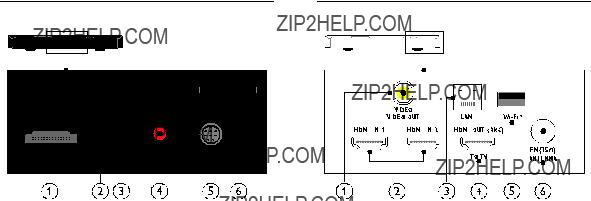
AWireless Rear Audio
Connect to a Philips wireless module.(Model: Philips RWSS5512, sold separately)
BDIGITAL
Connect to a coaxial audio output on the TV or a digital device.
CDIGITAL
Connect to an optical audio output on the TV or a digital device.
DAUDIO
Connect to an analog audio output on the TV or an analog device.
EDOCK for iPod
Connect to a Philips dock for iPod or iPhone. (Model: Philips DCK306x)
FSD CARD FOR
Slot for SD card.The SD card is used to rent online videos and access
A
Connect to the composite video input on the TV.
BHDMI IN1 / HDMI IN2
Connect to the HDMI output on a digital device.
CLAN
Connect to the LAN input on a broadband modem or router.
DHDMI OUT (ARC)TO TV
Connect to the HDMI input on the TV.
E
Connect to a
FANTENNA FM 75 
Signal input from an antenna, cable or satellite.
8 EN
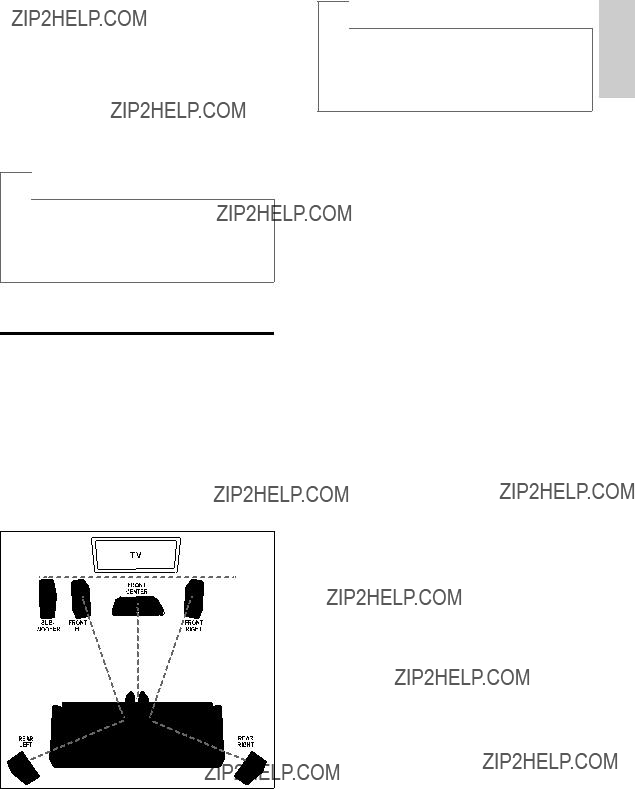
4 Connect and set up
This section helps you connect your home theater to a TV and other devices, and then set it up.
For information about the basic connections of your home theater and accessories, see the quick start guide. For a comprehensive interactive guide, visit www.connectivityguide.philips.com.
 Note
Note
?????? For identification and supply ratings, see the type plate at the back or bottom of the product.
?????? Before you make or change any connections, make sure that all devices are disconnected from the power outlet.
Connect speakers
The speaker cables are
Speaker position plays a critical role in setting up a surround sound effect. For best effect, position all the speakers towards the seating position and place them close to your ear level (seated).
 Note
Note
?????? Surround sound depends on factors such as room shape and size, type of wall and ceiling, windows and reflective surfaces, and speaker acoustics. Experiment with the speaker positions to find the optimum setting for you.
Follow these general guidelines for speakers
placement.
1
2
3
4
5
English
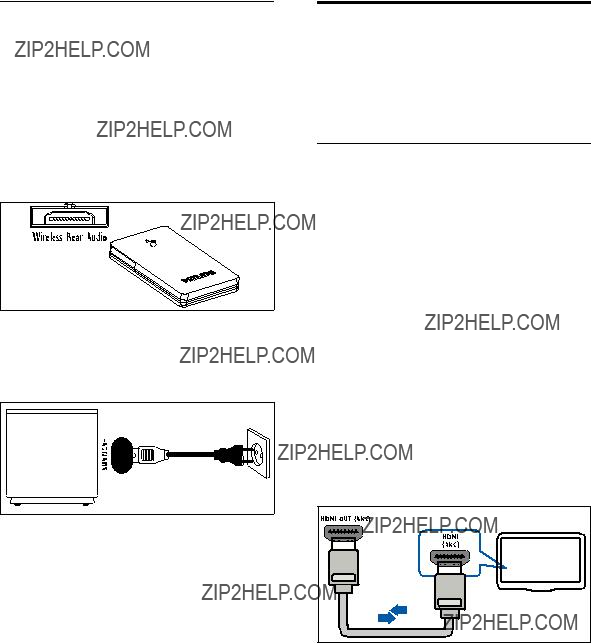
Make your rear speakers wireless
Connect the rear speakers to your home theater wirelessly using a wireless module accessory. For details, see the wireless module user manual.
What you need
???A Philips wireless module. (Model: Philips RWSS5512, sold separately)
1 Connect the wireless transmitter to the
Wireless Rear Audio connector on your
home theater.
2 Connect the rear speakers to the wireless receiver.
3 Connect the wireless receiver to the power
Connect to TV
Connect your home theater to a TV to watch videos.You can listen to the TV audio through your home theater speakers.
Use the best quality connection available on your home theater and TV.
Option 1: Connect to TV through HDMI (ARC)
Best quality video
Your home theater supports HDMI version
1.4 - Audio Return Channel (ARC). If your TV is HDMI ARC compliant, you can hear the TV audio through your home theater by using a single HDMI cable.
1 Using a High Speed HDMI cable, connect the HDMI OUT (ARC) connector on your home theater to the HDMI ARC connector on the TV.
??? The HDMI ARC connector on the TV might be labeled differently. For details, see the TV user manual.
2 On your TV, turn on
??? If you cannot hear the TV audio through your home theater, set up the audio manually (see 'Set up the audio' on page 14).
10 EN
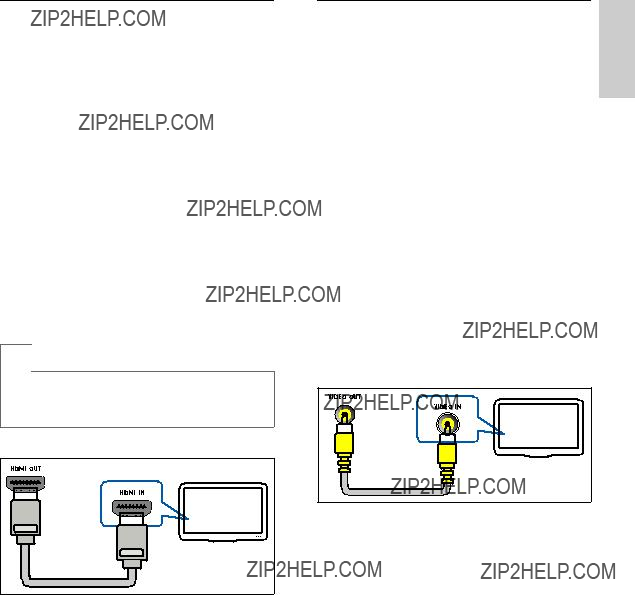
Option 2: Connect to TV through standard HDMI
Best quality video
If your TV is not HDMI ARC compliant, connect your home theater to the TV through a standard HDMI connection.
1 Using a High Speed HDMI cable, connect the HDMI OUT (ARC) connector on your home theater to the HDMI connector on the TV.
2 Connect an audio cable to hear the TV audio through your home theater (see 'Connect
a composite video connection. A composite
connection does not support
1
??? The composite video connector might be labeled AV IN, COMPOSITE, or
audio from TV and other devices' on page 12).
3 On your TV, turn on
??? If you cannot hear the TV audio through your home theater, set up the audio manually (see 'Set up the audio' on page 14).
 Note
Note
2
3
4
BASEBAND.
?????? If your TV has a DVI connector, you can use an HDMI/DVI adapter to connect to TV. However, some of the features may not be available.
EN 11
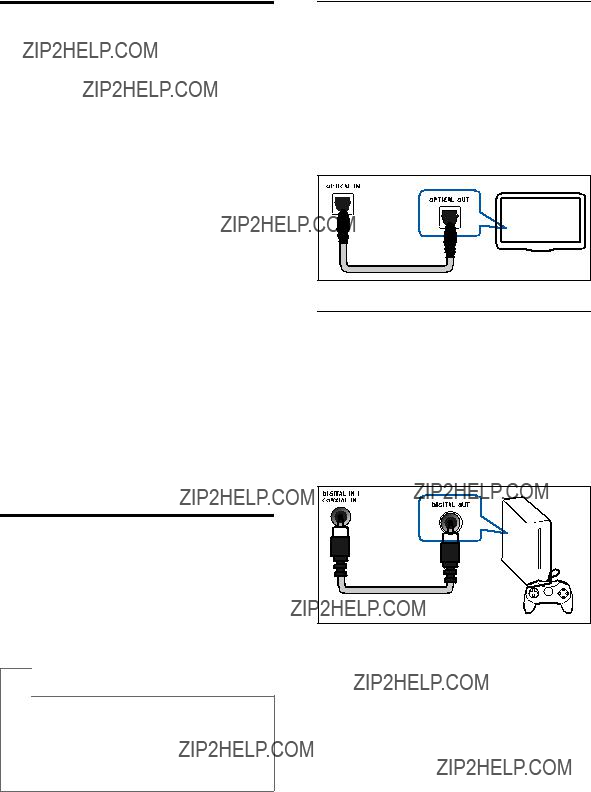
Connect digital devices through
HDMI
Connect a digital device such as a
???video is automatically displayed on your TV, and
???audio is automatically played on your home theater.
1 Using a High Speed HDMI cable, connect the HDMI OUT connector on your digital device to the HDMI IN 1/2 on your home theater.
2 Connect your home theater to TV through
HDMI OUT (ARC).
??? If the TV is not HDMI CEC compliant, select the correct video input on your TV.
3 On the connected device, turn on HDMI- CEC operations. For details, see the user manual of the device.
???If you cannot hear the digital device audio through your home theater, set up the audio manually (see 'Set up the audio' on page 14).
???You can also press SOURCE on your home theater repeatedly to select the correct HDMI input.
Connect audio from TV and other devices
Play audio from TV or other devices through your home theater speakers.
Use the best quality connection available on your TV, home theater, and other devices.
 Note
Note
?????? The audio connections in this user manual are only recommendations.You can use other connections too.
?????? When your home theater and TV are connected through HDMI ARC, an audio connection is not required.
Option 1: Connect audio through a digital optical cable
Best quality audio
1 Using an optical cable, connect the OPTICAL connector on your home theater to the OPTICAL OUT connector on the TV or other device.
???The digital optical connector might be labeled SPDIF or SPDIF OUT.
Option 2: Connect audio through a digital coaxial cable
Good quality audio
1 Using a coaxial cable, connect the COAXIAL connector on your home theater to the
COAXIAL/DIGITAL OUT connector on the
TV or other device.
???The digital coaxial connector might be labeled DIGITAL AUDIO OUT.
12 EN
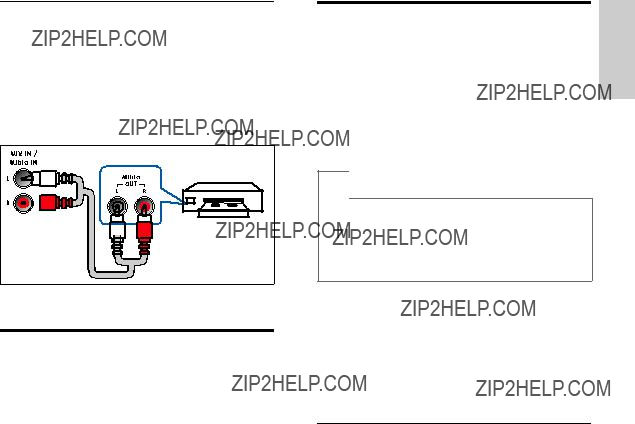
Option 3: Connect audio through analog audio cables
Basic quality audio
1 Using an analog cable, connect the AUX connectors on your home theater to the AUDIO OUT connectors on the TV or other device.
Set up speakers
Set up the speakers manually to experience customized surround sound.
Before you start
Make the necessary connections described in the quick start guide, and then switch the TV to the correct source for your home theater.
1 Press  (Home).
(Home).
2 Select [Setup], and then press OK.
3 Select [Audio] > [Speaker setup]
4 Enter the distance for each speaker, and then listen to the test tones and change the volume. Experiment with the speaker positions to find the ideal setting.
Set up EasyLink
This home theater supports Philips EasyLink, which uses the
 Note
Note
?????? Depending on the manufacturer,
?????? Philips does not guarantee 100% interoperability with all
Before you start
???Connect your home theater to the HDMI- CEC compliant device through HDMI connection.
???Make the necessary connections described in the quick start guide, and then switch the TV to the correct source for your home theater.
Enable EasyLink
1 Press  (Home).
(Home).
2 Select [Setup], and then press OK.
3 Select [EasyLink] > [EasyLink] > [On] .
4 On your TV and other connected devices, turn on
???On your TV, set the audio output to
'Amplifier' (instead of TV speakers). For details, see the TV user manual.
English
EN 13
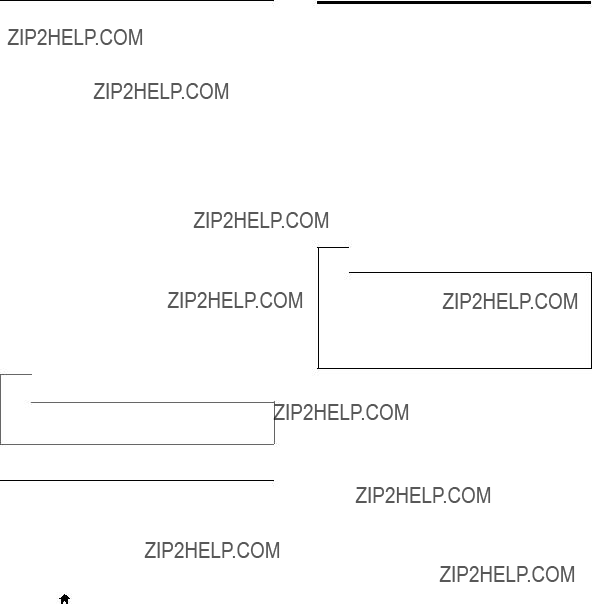
EasyLink controls
With EasyLink, you can control your home theater, TV, and other connected
???[One Touch Play]  (Play) to wake up the TV from standby, and then play a disc.
(Play) to wake up the TV from standby, and then play a disc.
???[One Touch Standby]
???[System Audio Control] (System audio control): If system audio control is enabled, the audio of the connected device is output through your home theater speakers automatically when you play the device.
???[Audio Input Mapping] (Audio input mapping):If system audio control does not work, map the connected device to the correct audio input connector on your home theater (see 'Set up the audio' on page 14).
 Note
Note
?????? To change the EasyLink control settings, press  (Home), select [Setup] > [EasyLink].
(Home), select [Setup] > [EasyLink].
Set up the audio
If you cannot hear the audio output of a connected device through your home theater speakers, check that you have enabled Easylink on
Connect and set up a home network
Connect your home theater to a network router through wired or wireless network connection, and enjoy:
???Streamed multimedia content (see 'Browse PC through DLNA' on page 24)
???Smartphone control
???Online TV (see 'Browse Online TV' on page 23)
???Software update (see 'Update software through the Internet' on page 30)
 Caution
Caution
?????? Familiarize yourself with the network router, media server software and networking principles. If necessary, read documentation that accompanies the network components. Philips is not responsible for lost, damaged, or corrupt data.
Before you start
???For Online TV and software updates, make sure that the network router has access to the Internet with
???Make the necessary connections described in the quick start guide, and then switch the TV to the correct source for your home theater.
14 EN
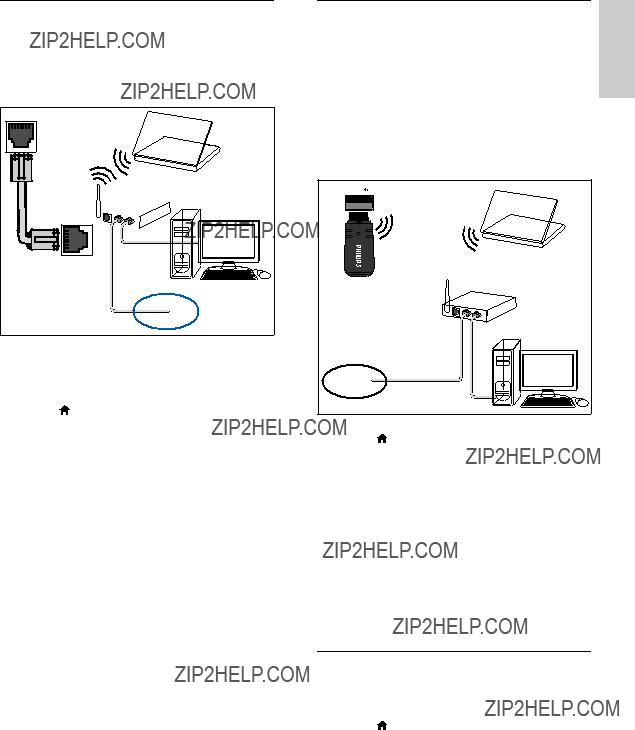
Set up the wired network
What you need
???A network cable (RJ45 straight cable).
???A network router (with DHCP enabled).
???To view the network settings, select
[Setup] > [Network] > [View network settings].
Set up the wireless network
???A network router (with DHCP enabled). For best wireless performance, coverage, and compatibility, use 802.11n router;
???A
Personalize the network name
15

5Use your home theater
This section helps you use the home theater to play media from a wide range of sources.
Before you start
???Make the necessary connections described in the quick start guide and the user manual.
???Complete the
???Switch the TV to the correct source for your home theater (for example, HDMI, AV IN).
Access the home menu
The home menu provides easy access to connected devices, setup and other useful features in your home theater.
1 Press  (Home).
(Home).
????The home menu is displayed.
2 Press the Navigation buttons and OK to
select the following:
??? [play Disc]: Start disc play.
??? [browse USB]: Access the USB content browser
Discs
Your home theater can play DVDs,VCDs, CDs, and
music.
1
2
3
 Note
Note
?????? To avoid flickering, change the brightness of the display.
Play buttons
Button Action
Navigation Navigate menus.
buttons Up/Down: Rotate the picture clockwise or
DISC/ Access or exit the disc menu.
MENU
 Access the advanced options when OPTIONS you play your audio, video, or media
Access the advanced options when OPTIONS you play your audio, video, or media
files (see 'Audio, video, and picture options' on page 19).
16 EN

Synchronize picture and sound
Play
Your home theater can play
What you need
???A 3D TV.
???A pair of 3D glasses that are compatible with your 3D TV.
???A 3D
???A high speed HDMI cable (preferably version 1.4)
1 Using the high speed HDMI cable, connect your home theater to a 3D compatible TV.
2 Make sure that the 3D video setting is enabled. Press  (Home), select [Setup] >
(Home), select [Setup] >
[Video] > [Watch 3D video] > [Auto].
??? To play 3D discs in 2D mode, select
[Off].
3 Play a
???During video search and in certain play modes, the video is displayed in 2D.The video display returns to 3D when you resume play.
Bonus View on
On
1
2
3 Select [PIP selection] > [PIP].
??? Depending on the video, PIP menu [1] or [2] is displayed.
??? To disable Bonus View, select [Off].
4 Select [2nd audio language] or [2nd Subtitle Language].
5 Select the language, and then press OK.
Access additional features on the
What you need
???
???Storage device:
???a USB storage device, with at least 1 GB of memory, or
???an SD memory card of type SDHC Class 6, with at least 8 GB of memory.
1 Connect your home theater to a home network with Internet access (see 'Connect and set up a home network' on page 14).
2 Connect a USB storage device or insert a SD memory card to your home theater.
???Use either a USB storage device or SD memory card to store the downloaded
English
EN 17
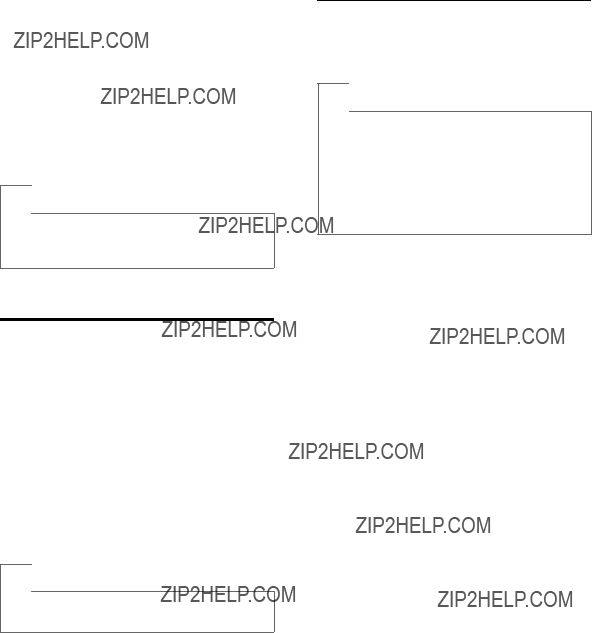
6 Select [Advanced] >
[Off] to enable
??? To disable
7 Select the
????
8 Press the Navigation buttons to navigate BD- Live, and then press OK to select an option.
 Note
Note
?????? To clear the memory on the storage device, press  (Home), select [Setup] > [Advanced] > [Clear memory].
(Home), select [Setup] > [Advanced] > [Clear memory].
Data files
Your home theater can play pictures, audio and video files contained in a disc or a USB storage device. Before you play a file, check that the file format is supported by your home theater (see
'File formats' on page 31).
1
2 To stop play, press  .
.
???To resume the video from where you stopped, press  (Play).
(Play).
???To play the video from the start, press  .
.
 Note
Note
?????? To play DivX DRM protected files, connect your home theater to a TV through an HDMI cable.
Subtitles
If your video has subtitles in multiple languages, select a subtitle language.
 Note
Note
?????? Make sure that the subtitle file has the exact same name as the video file. For example, if the video file is named 'movie.avi', name the subtitle file as 'movie.srt' or 'movie.sub'.
?????? Your home theater supports the following file formats: .srt, .sub, .txt, .ssa, .ass, smi, and .sami. If the subtitles do not appear correctly, change the character set.
1 While playing video, press SUBTITLE to select a language.
2 For DivX or RMVB/RM videos, if the subtitles do not appear correctly, continue the following steps to change the character set.
3 Press  OPTIONS.
OPTIONS.
????The options menu is displayed.
4 Select [Character set], and then select a character set that supports the subtitle.
Europe, India, LATAM, and Russia
18 EN

Asia Pacific and China
VOD code for DivX
Before you purchase DivX videos and play them
????The DivX VOD registration code for your home theater is displayed.
USB storage devices
Enjoy pictures, audio, and video stored on a USB storage device such as an MP4 player or digital camera.
What you need
???A USB storage device that is formatted for
FAT or NTFS file systems, and complies with the Mass Storage Class.
 Note
Note
?????? If you use a USB extension cable, USB HUB, or USB
1 Connect a USB storage device to the  (USB) connector on your home theater.
(USB) connector on your home theater.
2 Press  (Home).
(Home).
3 Select [browse USB], and then press OK. ????A content browser is displayed.
4 Select a file, and then press OK.
5 Press the play buttons to control play (see 'Play buttons' on page 16).
Audio, video, and picture options
Use advanced features when you play pictures, audio
and video files from a disc or a USB storage device.
Audio options
While playing audio, repeat an audio track, a disc, or a folder.
1 Press  OPTIONS repeatedly to cycle through the following functions:
OPTIONS repeatedly to cycle through the following functions:
???RPT TRAC / RPT FILE: Repeat the current track or file.
???RPT DISC / RPT FOLD: Repeat all the tracks on the disc or the folder.
???RPT RAND: Play audio tracks in random order.
???RPT OFF:Turn off the repeat mode.
Video options
While watching video, select options such as subtitles, audio language, time search, and picture settings. Depending on the video source, some options are not available.
1 Press  OPTIONS.
OPTIONS.
????The video options menu is displayed.
2 Press the Navigation buttons and OK to
select and change:
???[Audio language]: Select audio language for video.
???[Subtitle Language]: Select subtitle language for video.
???[Subtitle shift]: Change the subtitle position on the screen.
???[Info]: Display information about what is playing.
???[Character set]: Select a character set that supports the DivX subtitle.
???[Time search]: Skip to a specific part of the video by entering the time of the scene.
???[2nd audio language]: Select the second audio language for
???[2nd Subtitle Language]: Select the second subtitle language for
???[Titles]: Select a specific title.
???[Chapters]: Select a specific chapter.
???[Angle list]: Select a different camera angle.
???[Menus]: Display the disc menu.
English
EN 19

???[PIP selection]: Display
???[Zoom]: Zoom into a video scene or picture. Press the Navigation buttons
(left/right) to select a zoom factor.
???[Repeat]: Repeat a chapter or title.
???[Repeat
???[Picture settings]: Select a predefined color setting.
???[Karaoke] (Available only in Asia Pacific and China): Change the karaoke settings.
Picture options
While viewing a picture, zoom into the picture, rotate it, add animation to a slideshow, and change the picture settings.
1 Press  OPTIONS.
OPTIONS.
????The picture options menu appears.
2 Press the Navigation buttons and OK to
select and change the following settings:
???[Rotate +90]: Rotate the picture 90 degree clockwise.
???[Rotate
???[Zoom]: Zoom into a video scene or picture. Press the Navigation buttons
(left/right) to select a zoom factor.
???[Info]: Display picture information.
???[Duration per slide]: Select the display speed for each picture in a slide show.
???[Slide animation]: Select animation for the slide show.
???[Picture settings]: Select a predefined color setting.
???[Repeat]: Repeat a selected folder.
Musical slideshow
Radio
Listen to FM radio on your home theater, and store up to 40 radio stations.
 Note
Note
?????? AM and digital radio are not supported.
?????? If no stereo signal is detected, or if fewer than five stations are found, you are prompted to install the radio stations again.
1 Connect the FM antenna to the ANTENNA FM 75  on your home theater.
on your home theater.
??? For the best reception, place the antenna away from the TV or other sources of radiation.
2 Press Source buttons repeatedly until RADIO appears on the display panel.
????If you have already installed the radio stations, the last channel that you listened to is played.
????If you have not installed any radio stations, the message AUTO INSTALL...PRESS PLAY appears on the display panel. Press  (Play).
(Play).
3 Use the remote control to listen or to change radio stations.
20 EN

Play buttons
Tuning grid
In some countries, you can toggle the FM tuning
kHz or 100 kHz.
MP3 player
Connect a MP3 player to play audio files.
What you need
???An MP3 player.
???A 3.5mm or 6.5mm stereo audio cable.
1 Using the 3.5mm or 6.5mm stereo audio cable, connect the MP3 player to the MUSIC iLINK connector on your home theater.
??? If you use 6.5mm stereo audio cable, connect the MP3 player to your home theater using a 3.5mm - 6.5mm converter jack.
2 Press AUDIO SOURCE repeatedly until MUSIC
3 Press the buttons on the MP3 player to select and play audio files.
iPod or iPhone
Connect a Philips dock to play music, photos, and videos from your iPod or iPhone.
What you need
???A Philips dock (model: Philips DCK306x).
???A yellow composite video cable.
1 Connect the Philips dock to the DOCK for iPod connector on your home theater.
2 To view slideshow from your iPod or iPhone on your TV, connect the dock to the TV by using the yellow composite cable.
3 Switch on the iPod or iPhone, and place it on the dock.
???Charge your iPod/iPhone on the dock while the home theater is in iPod mode.
English
EN 21

Play music
1 Dock your iPod or iPhone.
2 Press DOCK for iPod on the home theater remote control.
3 Browse your iPod or iPhone screen to select the music.
4 Play the music on your iPod or iPhone.
????The music is heard on your home theater.
Browse the audio content from your TV (extended mode):
1 Press  (Home).
(Home).
2
3
4
??? The local keys on your iPod or iPhone
Smartphone control
Use your mobile device such as iPhone (iOS 3.1.3 and above), Android phone (2.1 and above), iPad, or tablet to:
???Control your home theater
???Browse a data disc or USB storage device
Before you start
???Connect your home theater, mobile device, and other
???For better video quality, use wired connection whenever possible.
???Personalize the network name for your home theater (see 'Personalize the network name' on page 15).
???Download Philips MyRemote application on your mobile device.
???For iPhone or iPad, search for the app in App Store (App Store).
???For Android based phone or tablet, search for the app in Market (Market).
5
are disabled.
Control your home theater
Play video and slideshow
1 Dock your iPod or iPhone (see 'iPod or iPhone' on page 21).
2 Press DOCK for iPod on the home theater remote control.
3 Switch the TV to the AV/VIDEO source (corresponding to the yellow composite cable).
????The TV screen goes blank.
Control your home theater from the mobile device.
1 On the mobile device, access MyRemote (MyRemote) application.
2 Select your home theater (by its network name) from the home screen.
????A browsing bar is displayed at the bottom of the screen.
??? If your home theater is not found, check the network connection or tap the Devices (Devices) tab on your mobile
4 From the iPod or iPhone screen, browse and play a video or photo slideshow.
????The video or photo slideshow is displayed on your TV.
3
device to search again.
22 EN
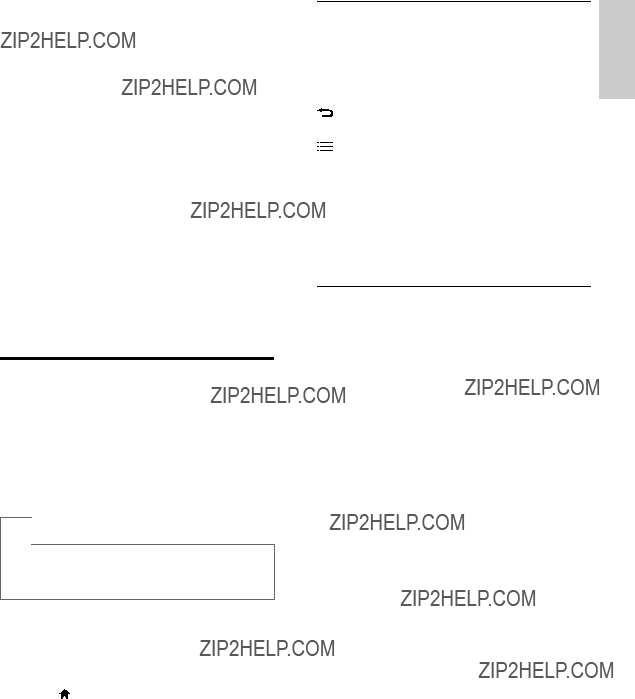
4 Follow the onscreen instructions to select an option or complete the set up.
Browse Online TV
Use Online TV to access variety of internet applications and specially adapted internet websites.
For interactive discussions on Online TV services, visit the Online TV forum at www.supportforum. philips.com
 Note
Note
?????? Koninklijke Philips Electronics N.V. bears no responsibility for content provided by Online TV service providers.
Navigate Online TV
Use a
What you need
???A wired or wireless USB hub, keyboard, or mouse that complies with the Human Interface Design
1 Connect a USB keyboard or mouse to the  (USB) connector on your home theater.
(USB) connector on your home theater.
???To connect a wireless USB device, connect the wireless receiver to the USB connector on your home theater. Refer to the user manual of the wireless USB device for details.
Press  (Home).
(Home).
Select [Setup], and then press OK.
Select [Preference] > [Keyboard layout].
Select a language.
????The standard keyboard for that language is enabled.
6 Use the keyboard to type the characters, or mouse to navigate the web page.
???
???The multimedia keys on some keyboards are not supported.
EN 23

Clear browsing history
Rent online video
Not available in China
Rent videos from online stores, through your home theater.You can watch them right away or later.
Many online video stores offer a huge choice of video, with different rental prices, periods, and conditions. For some stores, you must create an account before you can rent.
What you need
???An SD memory card of type SDHC Class 6, with at least 8GB of memory.
Browse PC through DLNA
Access and play the pictures, audio and video files from a computer or media server on the home network through your home theater.
Before you start
???Install a
???Windows Media Player 11 or higher for
PC
???Twonky Media Server for Mac or PC
???Enable media sharing of files. For details, check the user manual of the media server software software.
'Play buttons' on page 16).
24 EN
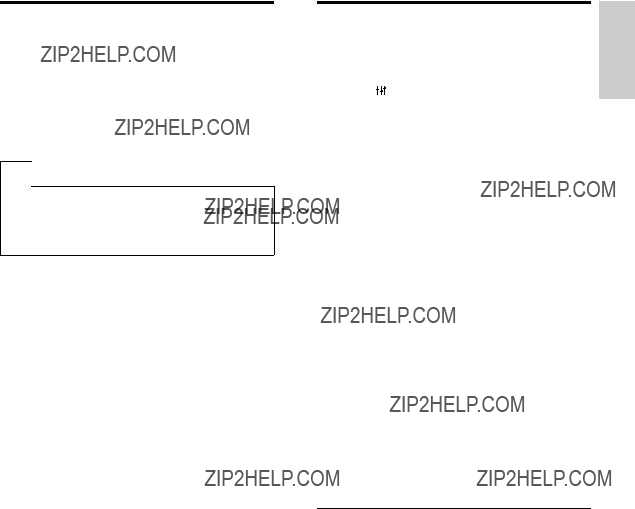
Karaoke
Available only in selected model and region
Play a Karaoke disc on your home theater and sing along with the music.
What you need
???A Karaoke microphone.
???Karaoke discs.
 Caution
Caution
?????? To prevent loud feedback or unexpected noise, turn the microphone volume to the minimum before you connect the microphone to your home theater.
1 Connect a karaoke microphone to the MIC connector on your home theater.
2 Switch your TV to the correct source for your home theater.
3 Make sure that audio post processing is enabled on your home theater (see 'Speaker settings' on page 28).
4 While playing a karaoke disc, press 
OPTIONS.
????The options menu is displayed.
5 Select [Karaoke], and then press OK. ????The karaoke setup menu is displayed.
6 Press the Navigation buttons (up/down) and OK to change the following settings:
???[Microphone]:Turn the microphone on or off.
???[Microphone volume]: Change the microphone volume.
???[Echo]: Change the echo level.
???[Key]: Change the pitch to match your voice.
Choose sound
3 Select an option, and then press OK.
4 Press  BACK to exit.
BACK to exit.
???If you do not press a button within a minute, the menu exits automatically.
Surround sound mode
Experience an immersive audio experience with surround sound modes.
1 Press 
 SOUND SETTINGS.
SOUND SETTINGS.
2 Select SURROUND, and then press OK.
3
English
4

Sound mode
Select predefined sound modes to suit your video
or music.
1
2 Press 
 SOUND SETTINGS.
SOUND SETTINGS.
3 Select SOUND, and then press OK.
4 Press the Navigation buttons (up/down) to select a setting on the display:
??? AUTO: Automatically select MOVIE or MUSIC based on the sound stream.
??? MOVIE: Enjoy a cinematic audio experience, specially enhanced for movies.
??? MUSIC: Recreate the original recording environment of your music, in the studio or at a concert.
??? ORIGINAL: Experience the original sound of your movies and music, without added sound effects.
??? NEWS: Hear every word with optimized speech and clear vocals.
??? GAMING: Enjoy thrilling arcade sounds, ideal for
5 Press OK to confirm.
Equalizer
Change the high frequency (treble), mid frequency
Auto volume
6 Change settings
The home theater settings are already configured for optimal performance. Unless you have a reason to change a setting, we recommend that you keep the default setting.
 Note
Note
?????? You cannot change a setting that is grayed out.
?????? To return to the previous menu, press  BACK.To exit the menu, press
BACK.To exit the menu, press  (Home).
(Home).
Language settings
1 Press  (Home).
(Home).
2 Select [Setup], and then press OK.
3 Select [Preference], and then press OK.
4 Press the Navigation buttons and OK to
select and change:
???[Menu language]: Select a display language for menu.
???[Audio]: Select an audio language for discs.
???[Keyboard layout]: Select a keyboard in your language.
???[Subtitle]: Select a subtitle language for discs.
???[Disc menu]: Select a menu language for discs.
 Note
Note
?????? If your preferred disc language is not available, select [Others] from the list, and enter the
?????? If you select a language that is not available on a disc, the home theater uses the default language of the disc.
26 EN

Picture and video settings
1 Press  (Home).
(Home).
2 Select [Setup], and then press OK.
3 Select [Video], and then press OK.
4 Press the Navigation buttons and OK to select and change:
???[TV display]: Select a picture format to fit the TV screen.
???[HDMI video]: Select the resolution of video signal that is output from HDMI OUT (ARC) on your home theater.
To enjoy the selected resolution, make sure that your TV supports the selected resolution.
???[HDMI Deep Color]: Recreate the natural world on your TV screen by displaying vivid images using billion colors. Your home theater must be connected to a Deep Color enabled TV through an HDMI cable.
???[Picture settings]: Select pre defined color settings for the video display. Select [User] to create your own setting.
???[Watch 3D video]: Set HDMI video to support 3D or 2D video.
???[User]: Select advanced settings for the video. Available only after you create
a preset called 'User' under picture settings.
 Note
Note
?????? If you change a setting, make sure that the TV supports the new setting.
Audio settings
select and change:
???[Night mode]: For quiet listening, decrease the volume of loud sounds on your home theater. Night mode is only available for
???[HDMI Audio]: Set the HDMI audio output from your TV, or disable HDMI audio output from the TV.
Parental control settings
1 Press  (Home).
(Home).
2 Select [Setup], and then press OK.
3 Select [Preference], and then press OK.
4 Press the Navigation buttons and OK to select and change:
???[Change Password]: Set or change your password for parental control access.
If you do not have a password or have forgotten your password, enter 0000.
???[Parental control]: Restrict access to discs that are recorded with age ratings. To play all discs, irrespective of the ratings, select 8 or [Off].
Display settings
1 Press  (Home).
(Home).
2 Select [Setup], and then press OK.
3 Select [Preference], and then press OK.
4 Press the Navigation buttons and OK to select and change:
???[Auto subtitle shift]: Enable or disable automatic repositioning of subtitles on TVs that support this feature.
???[Display panel]: Set the brightness of the home theater front panel display.
???[VCD PBC]: Enable or disable the content menu navigation of VCD and SVCD discs with Play Back Control feature.
EN 27
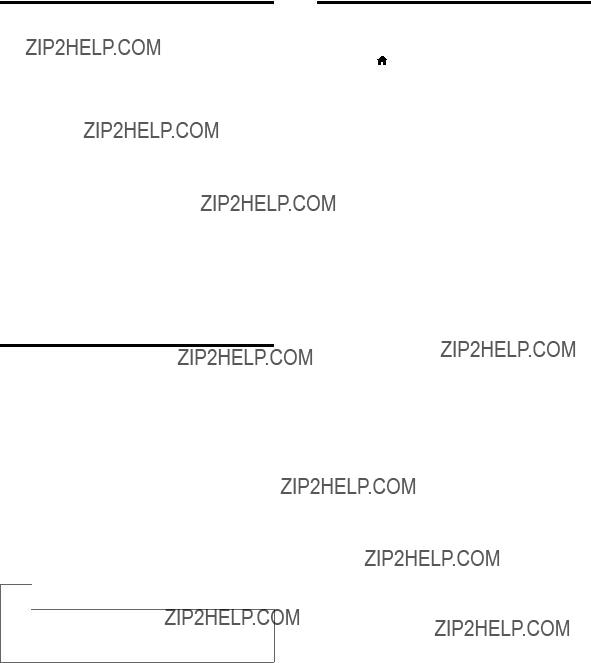
Energy saving settings
1 Press  (Home).
(Home).
2 Select [Setup], and then press OK.
3 Select [Preference], and then press OK.
4 Press the Navigation buttons and OK to select and change:
???[Screen saver]: Switch the home theater to screen saver mode after 10 minutes of inactivity.
???[Auto standby]: Switch the home theater to standby after 30 minutes of inactivity. This timer works only when a disc or USB play is paused or stopped.
???[Sleep timer]: Set the duration of the sleep timer so that the home theater is switched to standby after the specified period.
Speaker settings
1 Press  (Home).
(Home).
2 Select [Setup], and then press OK.
3 Select [Advanced], and then press OK.
4 Press the Navigation buttons and OK to select and change:
???[Enhanced audio]: Select [On] to enable audio post processing at the speaker and enable karaoke settings (if your product supports Karaoke).To play the original audio of the disc, select [Off].
 Tip
Tip
?????? Enable audio post processing before you select a predefined sound mode (see 'Sound mode' on page
26).
Restore default settings
????Your home theater is reset to its default settings except for some settings such as parental control and DivX VOD registration code.
28 EN
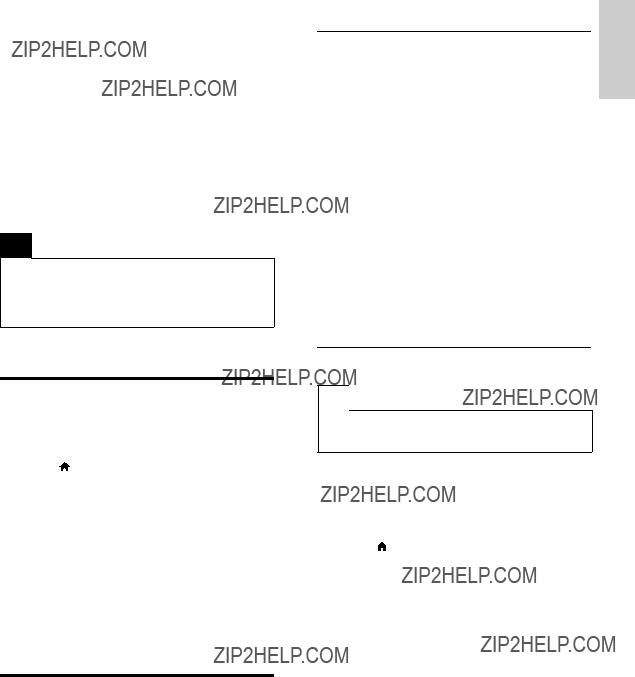
Step 1: Download the latest software
1 Connect a USB flash drive to your computer.
2 In your web browser, go to www.philips.com/ support.
3 At the Philips Support website, find your product and locate the Software and drivers. ????The software update is available as a zip
file.
4 Save the zip file in the root directory of your USB flash drive.
5 Use the archive utility to extract the software update file in the root directory.
????The files are extracted under the UPG_ ALL folder of your USB flash drive.
6 Disconnect the USB flash drive from your
computer.
Step 2: Update the software
 Caution
Caution
?????? Do not switch off the home theater or remove the USB flash drive during the update.
the update.
????Once complete, the home theater automatically switches off and restarts. If it does not, disconnect the power cord for a few seconds and then reconnect it.
EN 29
English
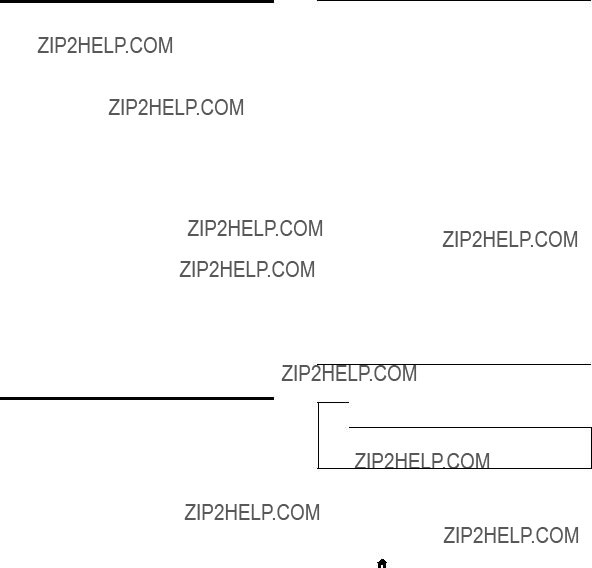
Update software through the Internet
1 Connect your home theater to a home network with a
2 Press  (Home).
(Home).
3 Select [Setup], and then press OK.
4 Select [Advanced] > [Software update] > [Network].
????If an upgrade media is detected, you are prompted to start or cancel the update.
5 Follow the onscreen instructions to confirm the update.
????Once complete, the home theater automatically switches off and restarts. If it does not, disconnect the power cord for a few seconds and then reconnect it.
Update the onscreen help
If the current version of the onscreen help is lower than the latest version available on www. philips.com/support, download and install the latest onscreen help (see 'Check software version' on page 29).
What you need
???A USB flash drive that is FAT or NTFS- formatted, with at least 35MB of memory. Do not use a USB hard drive.
???A computer with internet access.
???An archive utility that supports the ZIP file format.
Step 1: Download the latest onscreen help
1 Connect a USB flash drive to your computer.
2 In your web browser, go to www.philips.com/ support.
3 At the Philips support website, find your product and click on User manuals, and then locate the User Manual Upgrade Software.
????The help update is available as a zip file.
4 Save the zip file in the root directory of your USB flash drive.
5 Use the archive utility to extract the help update file in the root directory.
????A file named 'HTSxxxxeDFU.zip' is extracted under the UPG_ALL folder of your USB flash drive, 'xxxx' being the model number of your home theater.
6 Disconnect the USB flash drive from your
computer.
Step 2: Update onscreen help
 Caution
Caution
?????? Do not switch off the home theater or remove the USB flash drive during the update.
home theater.
30 EN
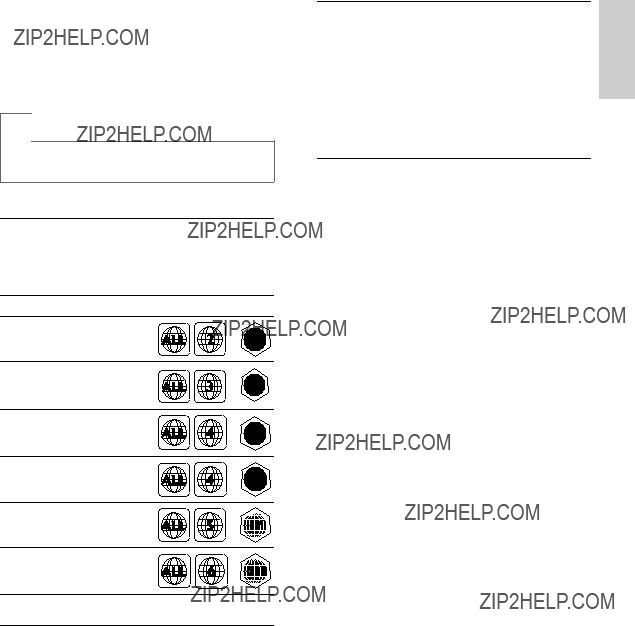
8Product specifications
 Note
Note
?????? Specifications and design are subject to change without notice.
Region codes
The type plate on the back or bottom of the home theater shows which regions it supports.
Media formats
???AVCHD, BD,
Video CD/SVCD, Picture files, MP3 media,
WMA media, DivX Plus HD media, USB storage device
File formats
???Audio: .aac, .mka, .mp3, .wma, .wav, .mp4, .m4a
???Video:
???.avi, .divx, .mp4, .mkv, .asf, .wmv, .mpg,
.mpeg,
???.rmvb, .rm (Available only in Asia Pacific and China)
???Picture: .jpg, .jpeg, .gif, .png
Audio formats
Your home theater supports the following audio files.
English
EN 31

Video formats
If you have a high definition TV, your home theater allows you to play your video files with:
???Resolution: 1920 x 1080 pixels at
???Frame rate: 6 ~ 30 frames per second.
.avi files in AVI container
.mkv files in MKV container
.rm and .rmvb files in RM container (Available only in Asia Pacific and China)
32 EN

Amplifier
???Total output power:
???1000W RMS (+/- 0.5 dB, 30% THD) /
800W RMS (+/- 0.5 dB, 10% THD)
???Frequency response: 20
???
???Input sensitivity:
???AUX: 1000 mV
???Music iLink: 350 mV
Video
???Signal system: PAL / NTSC
???HDMI output: 480i/576i, 480p/576p, 720p, 1080i, 1080p, 1080p24
Audio
???S/PDIF Digital audio input:
???Coaxial: IEC
???Optical:TOSLINK
???Sampling frequency:
???MP3: 32 kHz, 44.1 kHz, 48 kHz
???WMA: 44.1 kHz, 48 kHz
???Constant bit rate:
???MP3: 32 kbps - 320 kbps
???WMA: 48 kbps - 192 kbps
Radio
???Tuning range:
???Europe/Russia/China: FM
???Asia Pacific/Latin America: FM
MHz (50/100 kHz)
???
???Frequency response: FM 180
USB
???Compatibility:
???Class support: USB Mass Storage Class (MSC)
???File system: FAT16, FAT32, NTFS
Main unit
???Power supply:
???Europe/China:
???Latin America/Asia Pacific:
???Russia/India:
???Power consumption: 105 W
???Standby power consumption: ??? 0.5 W
???Dimensions (WxHxD): 435 x 56 x 344 mm
???Weight: 3.3 kg
Subwoofer
???Impedance: 4 ohm
???Speaker drivers: 165 mm (6.5") woofer
???Dimensions (WxHxD):
???HTS55x3 and HTS65x3/93: 178 x 303 x 343 mm
???HTS65x3/94: 196 x 395 x 342 mm
???Weight:
???HTS55x3 and HTS65x3/93: 3.84 kg
???HTS65x3/94: 5.2 Kg
English
EN 33
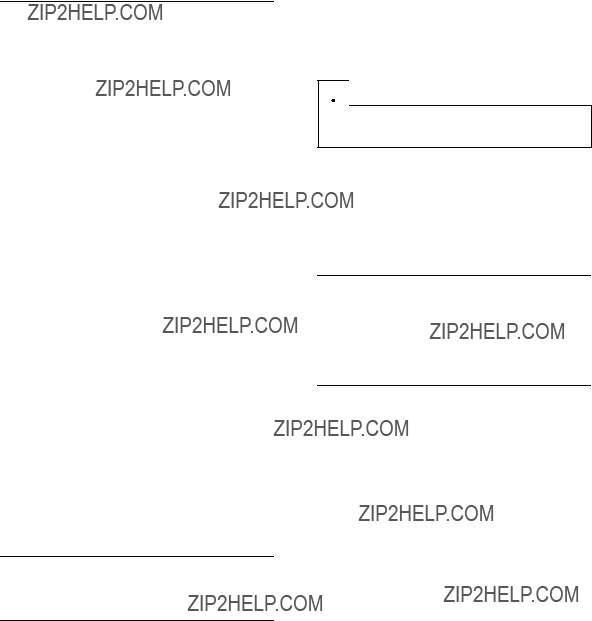
Speakers
Center speaker:
???Speaker impedance: 4 ohm
???Speaker drivers:
???HTS55x3: 1 x 76.2 mm (3") woofer
???HTS65x3: 2 x 76.2 mm (3") woofer
???Dimensions (WxHxD):
???HTS55x3: 223 x 101.5 x 93.5 mm
???HTS65x3: 280 x 95 x 92 mm
???Weight:
???HTS55x3: 0.61 kg
???HTS65x3: 0.97 kg
Front / rear speakers:
???Speaker impedance: 4 ohm
???Speaker drivers:
???HTS55x3: 1 x 76.2 mm (3") woofer
???HTS65x3: 2 x 76.2 mm (3") woofer
???Dimensions HTS55x3 (WxHxD):
???Satellite (small) speakers: 90 x 185 x 105.5 mm
???Tallboy (tall) speakers: 247 x 1091 x 242 mm
???Dimensions HTS65x3 (WxHxD):
???Satellite (small) speakers: 101 x 280 x 104 mm
???Tallboy (tall) speakers: 260 x 1101 x 260 mm
???Weight HTS55x3:
???Satellite (small) speakers: 0.54 kg each
???Tallboy (tall) speakers: 2.19 kg each
???Weight HTS65x3:
???Satellite (small) speakers: 0.87 kg each
???Tallboy (tall) speakers: 3.83 kg each
Remote control batteries
???2 x
Laser
???Laser Type (Diode): InGaN/AIGaN (BD), AIGaInP (DVD/CD)
???Wave length: 405 +7
???Output power (Max. ratings): 20 mW (BD), 6 mW (DVD), 7 mW (CD)
9 Troubleshooting
 Warning
Warning
?????? Risk of electric shock. Never remove the casing of the product.
To keep the warranty valid, never try to repair the product yourself.
If you have problems using this product, check the following points before you request service. If you still have a problem, get support at www.philips. com/support.
Main unit
The buttons on the home theater do not work.
???Disconnect the home theater from the power supply for a few minutes, then reconnect.
Picture
No picture.
???Make sure that the TV is switched to the correct source for the home theater.
No picture on a TV connected through HDMI.
???Make sure that you use a High Speed HDMI cable to connect the home theater and TV. Some Standard HDMI cables do not display properly for some images, 3D video, or Deep Color.
???Make sure that the HDMI cable is not faulty. If it is faulty, replace it with a new cable.
???Press  (Home) and then 731 on the remote control to restore the default picture resolution.
(Home) and then 731 on the remote control to restore the default picture resolution.
???Change the HDMI video setting, or wait for
10 seconds for auto recovery.
Disc does not play
???Make sure that the disc contains high- definition video.
???Make sure that the TV supports high- definition video.
???Use an HDMI cable to connect to the TV.
34 EN

Sound
No sound from home theater speakers.
???Connect the audio cable from your home theater to your TV or other devices. However, you do not need a separate audio connection when:
???the home theater and TV are connected through an HDMI ARC connection, or
???a device is connected to the HDMI IN connector on your home theater.
???Set up the audio for the connected device.
???Reset your home theater to its factory settings, and then switch it off and switch on again.
???On your home theater, press SOURCE repeatedly to select the correct audio input.
Distorted sound or echo.
???If you play audio from the TV through the home theater, make sure that the TV is
muted.
Audio and video are not synchronized.
???1) Press 
 SOUND SETTINGS. 2) Press the Navigation buttons (left/right) to select AUD SYNC, and then press OK. 3) Press the Navigation buttons (up/down) to synchronize the audio with the video.
SOUND SETTINGS. 2) Press the Navigation buttons (left/right) to select AUD SYNC, and then press OK. 3) Press the Navigation buttons (up/down) to synchronize the audio with the video.
Play
Cannot play a disc.
???Clean the disc.
???Make sure that the home theater supports the type of disc (see 'Media formats' on page 31).
???Make sure that the home theater supports the region code of the disc.
???If the disc is a DVD??RW or DVD??R disc,
make sure that it is finalized.
Cannot play a DivX file.
???Make sure that the DivX file is encoded according to the 'Home Theater Profile' with the DivX encoder.
???Make sure that the DivX file is complete.
DivX or RMVB/RM subtitles do not display correctly.
???Make sure that the subtitle file name is the same as the movie file name.
???Select the correct character set: 1) Press
 OPTIONS. 2) Select [Character set]. 3) Select the supported character set. 4) Press
OPTIONS. 2) Select [Character set]. 3) Select the supported character set. 4) Press
OK.
Cannot read the contents of a USB storage device.
???Make sure that the format of the USB storage device is compatible with the home theater.
???Make sure that the file system on the USB storage device is supported by the home
theater.
'No entry' or 'x' sign appears on the TV.
???The operation is not possible.
EasyLink does not work.
???Make sure that the home theater is connected to a Philips brand EasyLink TV, and
the EasyLink option is turned on (see 'Set up EasyLink
When you switch on the TV, the home theater automatically switches on.
???This behavior is normal when you are using Philips EasyLink
home theater work independently, switch off EasyLink.
Cannot access
???Make sure that the home theater is connected to the network. Use a wired network connection or wireless network connection.
???Make sure that the network is set up. Use a wired network installation or wireless network installation.
???Make sure that the
???Clear memory storage.
Cannot play video or photos from an iPod or iPhone on the TV.
???Browse and select videos and photos from the iPod or iPhone screen, and play them on your TV.
???Make sure that the iPod or iPhone software has not been tampered with or illegally
modified.
Cannot view pictures from an iPod or iPhone on the TV.
???Connect a yellow composite cable to the iPod dock and the TV.
???Switch the TV to the AV/VIDEO source (corresponding to the yellow composite cable).
???Press the play button on the iPod or iPhone to start a slideshow.
???Make sure that the iPod or iPhone software has not been tampered with or illegally modified.
English
EN 35

My 3D video played in 2D mode.
???Make sure that your home theater is connected to a 3D TV through an HDMI cable.
???Make sure that the disc is a
TV screen is black when you play a
???Make sure that the home theater is connected to the TV through an HDMI cable.
???Switch to the correct HDMI source on the TV.
Cannot download video from an online video store.
???Make sure that your home theater is connected to the TV through an HDMI cable.
???Make sure that the SD card is formatted, has enough memory to download the video, and is of type SDHC Class 6.
???Make sure that you have paid for the video, and it is within the rental period.
???Make sure that the network connection is good. Use a wired network connection or a wireless network connection.
???Visit the video store website for more information.
Network
Wireless network distorted or not found.
???Make sure that the wireless network is not disturbed by microwave ovens, DECT phones, or other neighboring
???Place the wireless router and the home theater within five meters of each other.
???Use a USB extension cable to connect the
???If the wireless network does not work properly, try a wired network installation.
10 Notice
This section contains the legal and trademark notices.
Open source software
Philips Electronics Singapore Pte Ltd hereby offers to deliver, upon request, a copy of the complete corresponding source code for the copyrighted open source software packages used in this product for which such offer is requested by the respective licenses.This offer is valid up to three years after product purchase to anyone in receipt of this information.To obtain source code, please contact open.source@philips.com. If you prefer not to use email or if you do not receive confirmation receipt within a week after mailing to this email address, please write to "Open Source Team, Philips Intellectual Property & Standards, P.O. Box 220, 5600 AE Eindhoven,The Netherlands". If you do not receive timely confirmation of your letter, please email to the email address above.The texts of the licenses and acknowledgements for open source software used in this product are included in the user manual.
36 EN
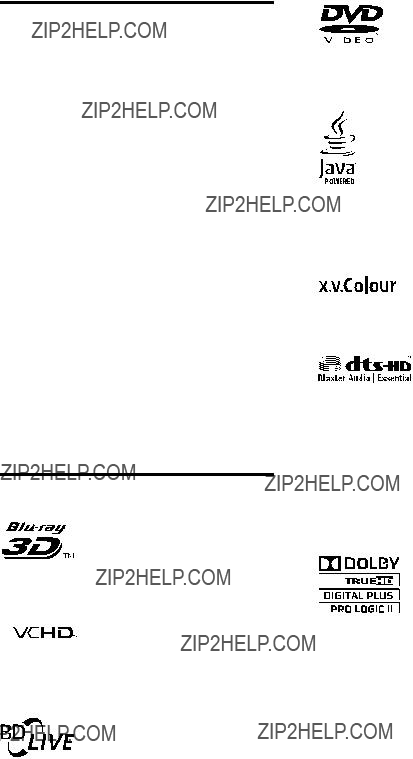
RMVB end user agreement
(Asia Pacific and China only)
Notes to End User:
By using this product with RealNetworks software and services, the end user agrees to the following terms of REALNETWORKS, INC:
???End User may only use the software for private,
???End User is not allowed to modify, translate, reverse engineer, decompile, dissemble or use other means to discover the source code or otherwise replicate the functionality of the Real Format Client Code, except to the extent that this restriction is expressly prohibited by applicable law.
???RealNetworks Inc. disclaims all warranties and conditions other than those set forth in this Agreement which are in lieu of all other warranties, whether express and implied, including but not limited to any implied warranties or conditions of merchantability and fitness for a particular purpose; and effectively exclude all liability for indirect, special, incidental and consequential damages, such as but not limited to lost profits.
Trademarks
'AVCHD' and 'AVCHD' logo are trademarks of Matsushita Electric Industrial Co., Ltd and Sony Corporation.
BONUSVIEW???
'BD LIVE' and 'BONUSVIEW' are trademarks of
Java and all other Java trademarks and logos are trademarks or registered trademarks of Sun Microsystems, Inc. in the United States and/or other countries.
'x.v.Colour' is a trademark of Sony Corporation.
Manufactured under license under U.S. Patent Nos: 5,956,674; 5,974,380; 6,226,616; 6,487,535; 7,392,195; 7,272,567; 7,333,929; 7,212,872 & other U.S. and worldwide patents issued & pending.  DTS, Inc. All Rights Reserved.
DTS, Inc. All Rights Reserved.
Manufactured under license from Dolby Laboratories. Dolby, Pro Logic, and the
EN 37

DivX  , DivX Certified
, DivX Certified  , DivX Plus
, DivX Plus  HD and associated logos are trademarks of Rovi
HD and associated logos are trademarks of Rovi
Corporation or its subsidiaries and are used under license.
ABOUT DIVX VIDEO: DivX  is a digital video format created by DivX, LLC, a subsidiary of Rovi
is a digital video format created by DivX, LLC, a subsidiary of Rovi
Corporation.This is an official DivX Certified  device that plays DivX video.Visit divx.com for more information and software tools to convert your files into DivX videos.
device that plays DivX video.Visit divx.com for more information and software tools to convert your files into DivX videos.
ABOUT DIVX  device must be registered in order to play purchased DivX
device must be registered in order to play purchased DivX
HDMI, the HDMI logo, and
Multimedia Interface are trademarks or registered trademarks of HDMI licensing LLC in the United States and other countries.
SDHC Logo is a trademark of
CLASS 1
LASER PRODUCT
38 EN

EN 39

12 Index
2
3
5
A
B
C
D
E
F
H
40 EN

I
K
L
M
N
O
P
play USB storage device
play video and slideshow from iPod power settings
predefined sound mode preference
program radio stations
R
radio recycling region codes remote control
S
SD card sleep timer slide animation smartphone software update software version sound
speaker position speaker setup speaker specifications subtitle language subtitle position surround sound
synchronize picture and sound system audio control
T
troubleshooting (network) troubleshooting (picture) troubleshooting (play) troubleshooting (sound) tune radio stations
tuning grid tuning grid
U
update onscreen help (user manual) update software (through Internet) update software (through USB)
USB storage device user manual
19
22
28
26
26
20
20
4
31
5
24
28
20
22
29
29
25
9
13
31
26
27
25
17
14
36
34
35
35
20
21
21
30
30
29
19
2
English
EN 41

V
W
42 EN
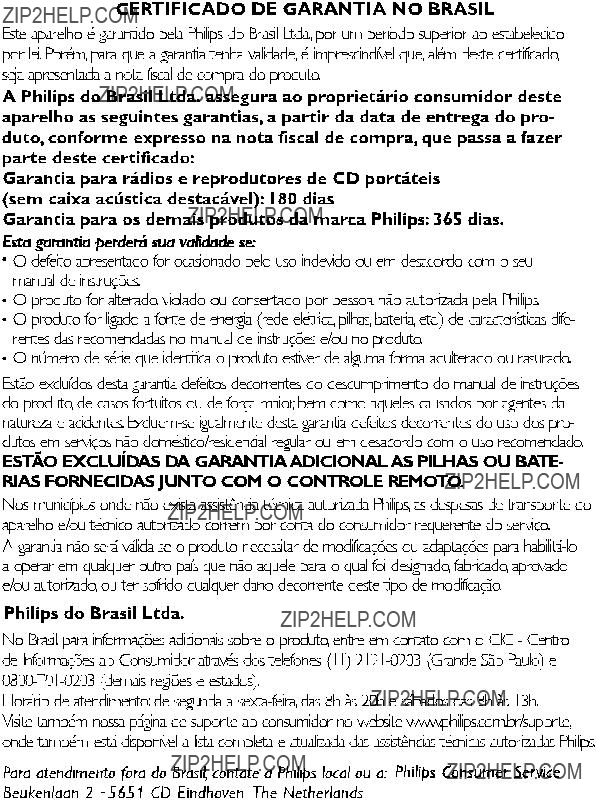
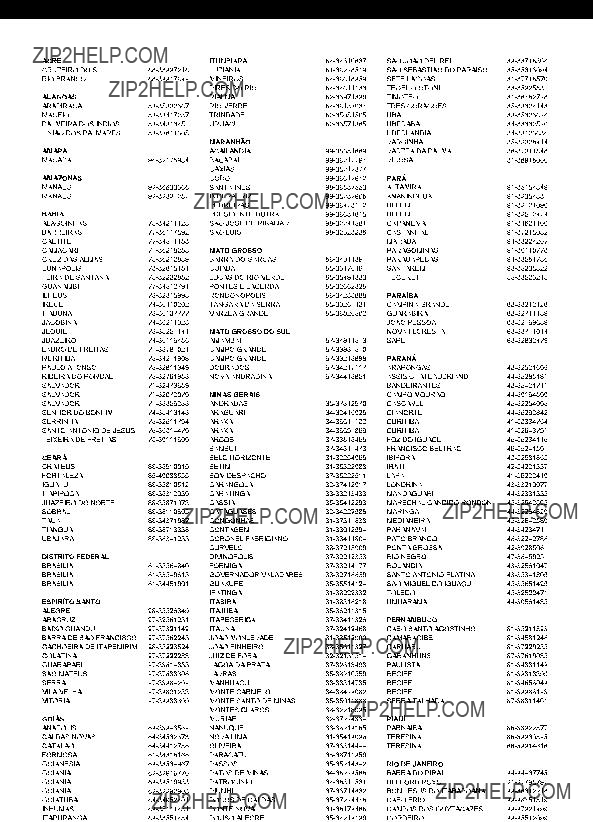
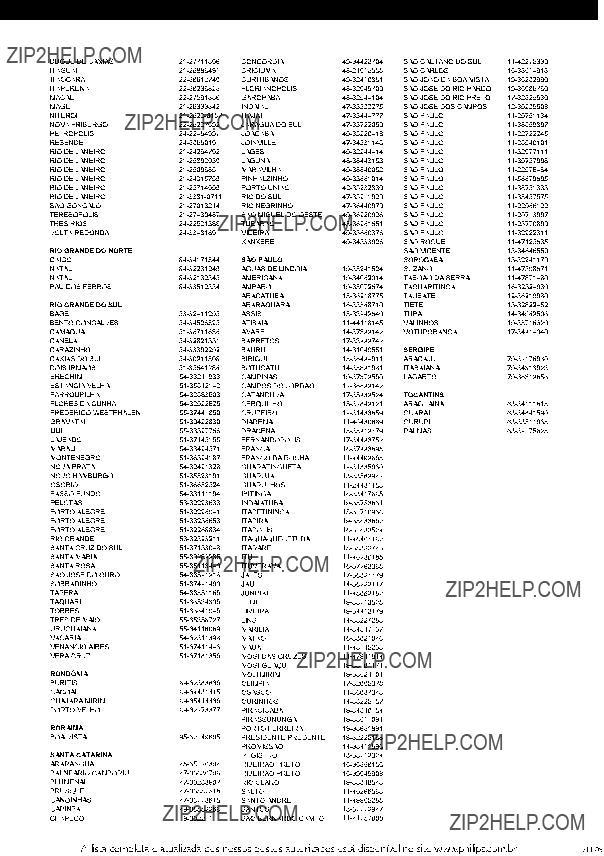

Seja Respons??vel
Respeite os direitos autorais
Especifica????es sujeitas a altera????o sem aviso pr??vio.
Marcas comerciais s??o propriedade de Koninklijke Philips Electronics N.V. ou de seus respectivos propriet??rios.
?? 2012 Koninklijke Philips Electronics N.V. All rights reserved.
sgpam_1201/78_v1